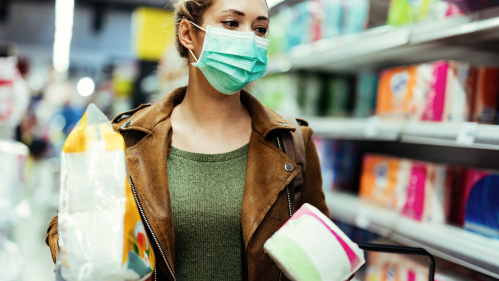Martin Blaser talks about controlling the spread of the virus and saving lives
As the coronavirus pandemic continues to spread rapidly across many parts of the United States – breaking records for new cases every day – questions loom about what the future will look like. Martin Blaser, director of Rutgers’ Center for Advanced Biotechnology and Medicine and professor of medicine and microbiology talks about our “new normal”, what we can expect in the months ahead and what we need to do to get the spread of the virus under control and save lives.
Are we expecting too much, too soon: opening businesses, going back to school, getting back to “normal” life?
Yes, we will need a graded approach – as long as the virus is circulating, we will not have "normal" life. Instead, there will be a "new normal", which is continuing to evolve day by day. Most reasonable people, parents, grandparents, don’t want to take unnecessary chances – so we have to find the right ways to thread the needle. We can’t stay home forever, but we can be much smarter than we were just a few months ago. This involves keeping our distances, avoiding crowded indoor spaces, wearing masks, washing your hands when you touch objects in public and isolating when ill. If everyone did this, the virus would not spread that quickly. We can visit with family or friends – but keep apart, no hugging and wear masks.
Why is the virus spreading so rapidly right now?
The virus is spreading because people are behaving badly. We aren’t breaking the chain of transmission in states where the infections are rising like wildfires because the virus has no mercy. It’s all about behavior.
What will happen if the virus is allowed to continue to spread rapidly in part of the country with no containment? Why is it important to slow transmission?
In 1918-1919, when there was a severe influenza outbreak, about 700,000 people died in the USA. Our country was a third the size it is now. That would translate today into 2 million deaths. This coronavirus has that same kind of potential (unless stopped by treatments or vaccines – which we do not yet have). So as bad as this has been, it could get a lot worse. Slowing down the spread of the virus buys time for scientists to develop new treatments, and to develop and deploy new vaccines. We are completely at the mercy of the virus until then, so the less it spreads, the fewer people who will get ill before the vaccine is around.
When is the earliest we can expect a vaccine? And are we putting too much emphasis on this occurring?
No one knows for certain how long it will be before we get a vaccine for COVID-19. The very earliest is the end of 2020, more likely, early 2021, if all goes well – but if not, it could be delayed.
I don’t think we are putting too much emphasis on a vaccine. There are only three important factors that will help decrease the infection rate and get our lives back to how they were before the coronavirus pandemic: developing a vaccine, therapies to markedly reduce the fatality rate, and social distancing and wearing a mask as I mentioned. There will be risk, at all ages, until we have the vaccine and/or better medical therapies.
What can we expect in the fall when flu season begins and we face seasonal flu and COVID-19 at the same time?
COVID-19 is much worse than the flu. I am predicting a rather small flu year – it is not as infectious as COVID in general, and the distancing, masks, hand-washing that reduces risk of COVID, also does the same for flu.
Is a mask – at this point in time, without a vaccine – still the best way to prevent spread? Will any mask work?
Mask plus social distancing is still the best way to prevent spread of the virus, along with hand washing. For clinical situations, the N95 mask is best; for ordinary life, all masks offer some degree of protection by covering the nose and mouth. In the earliest days of the epidemic, the public health authorities, knowing that using a mask does not give perfect protection, sought to dissuade people from wearing masks. Now we know that it is the best protection we have and that we all need to wear a mask to reduce spread. That may be one reason that the spread of the virus in East Asia has not been as bad as in the west; there is a culture there of wearing masks when ill, so it was not a big leap for most people there. We have been slow in getting to that level, and our slowness has been costly.



